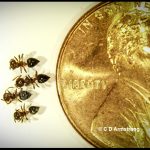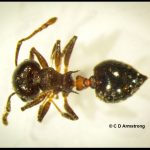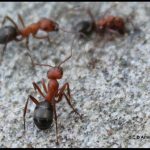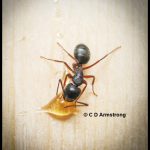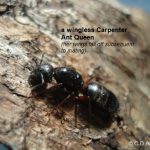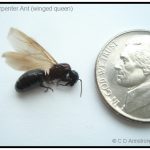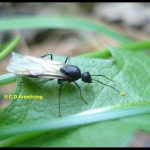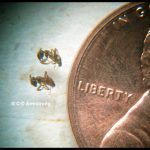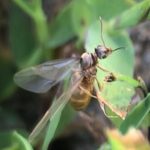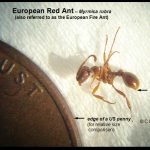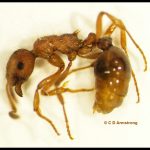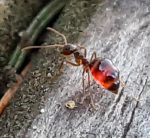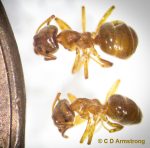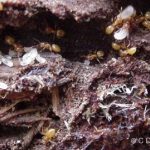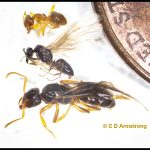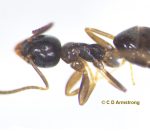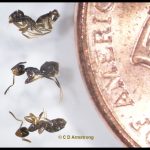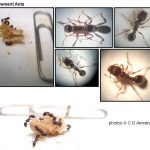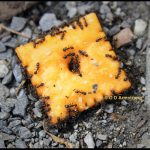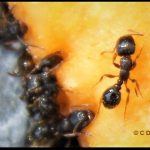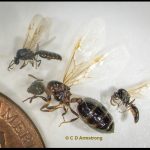Ants
Identification: If the information on these pages does not afford you a satisfactory or confident ID determination, don’t hesitate to make use of our Insect Diagnostic Lab. You can either send us a specimen, or upload a good (clear), closeup photo (or photos) for us using our Photo Submission Form. Depending on the particular ant in question, sometimes a really good photo is adequate. But when a photo is not sufficient by itself, our Submitting Specimens page will guide you through the process of submitting your specimens to our lab for identification.
People in Maine often mistake winged ants–especially if they are swarming–with winged termites. Due to our generally long and cold winters, however, termites have been quite rare in Maine, with only isolated cases that show up from time to time in some areas (primarily southern and coastal areas). Mississippi State Univ. Extension has a fact sheet with a helpful illustration that explains nicely the difference between the overall body design of a termite versus an ant: How to Distinguish Termites from Ants. Another resource about flying ants that is worth checking out is this UK Natural History Museum feature: Flying ant day: when winged ants take their nuptial flight
Although it is true that many ants are pests and/or a nuisance from a human perspective, ants are also beneficial in many ways, as discussed in the following two publications: Ants in Lawns [pdf] (UMass Extension) and Ants in Lawns (Iowa State University)
Photos of Some Ants that are found in Maine:
- Acrobat Ants (genus: Crematogaster) (note the heart-shaped abdomen) (specimens from New Gloucester, Maine; 6/8/2021)
- Closeup view of an Acrobat Ant (These ants are also called Valentine Ants because of the heart-shaped abdomen they possess) (specimen from New Gloucester, Maine; 6/8/2021)
- Allegheny Mound Ants (Bristol, ME 7/19/2017)
- Eastern Black Carpenter Ant (worker) feeding on a drop of honey (Camponotus pennsylvanicus) (central Maine; 4/8/2009)
-
Carpenter Ant Queen
(wingless stage) (the wings fall off subsequent to mating)
-
Carpenter Ant
(Winged Queen)
- A male Carpenter Ant (central Maine; 5/29/2015)
- Cornfield Ants (Lasius neoniger) (Farmington, ME; 4/14/2021)
- Cornfield Ant (winged queen during a swarm) (genus Lasius) (Wales, ME; 8/28/2023) (Photo courtesy of Karen Letourneau)
- European Red Ant — Myrmica rubra (also referred to as the European Fire Ant) (Invasive)
- European Red Ant (magnified view) — Myrmica rubra (also referred to as the European Fire Ant) (Invasive) (Calais, ME; June 10th, 2021)
- False Honey Ant (Prenolepis imparis) (April 2022) (Photo courtesy of Michael Patricks. Saco, Maine)
- Larger Yellow Ants (Lasius interjectus) (Hiram, ME; 9/15/2023) (among other unique characters, these ants have exceptionally small eyes relative to their head size)
- Larger Yellow Ants outdoors under a rotting log (These belong to a genus that is also known collectively as Citranella Ants)
- Larger Yellow Ants (Lasius interjectus) (Top to Bottom: worker, winged male, winged queen) (Hiram, ME; 9/15/2023)
- Odorous House Ant (Tapinoma sessile) (worker) (Portland, ME; 4/1/2024)
- Odorous House ants (workers, beside a US penny) (Portland, ME; 4/1/2024)
- Odorous House Ant (Tapinoma sessile) (worker) (Farmington, ME; 6/16/2022) (clear view of the single node between the thorax and abdomen which is often concealed by the abdomen)
- Pavement Ants (feeding on a cookie crumb)
- Pavement Ants feasting on a Cheez-It® cracker (Boothbay, Maine – 5/25/2019)
- Pavement ants (Closer and cropped view of the previous photo)
- Pavement ant reproductives (one queen and two smaller males) (Tetramorium immigrans) (Gardiner, ME; 9/1/2023) (next to a US penny for scale purposes)
Additional Photos and Information:
- Acrobat Ants (also called Valentine Ants) (genus Crematogaster)
- Allegheny Mound Ants (Formica exsectoides) — Beneficial to humans in some situations; two similar species we have in Maine: Formica pergandei and Formica aserva (BugGuide.net)
- Carpenter Ants (genus Camponotus) — Always check firewood for these ants before bringing it indoors.
- Citronella Ants — Ants in the genus Lasius are collectively referred to as Citronella Ants or sometimes Lemon Ants:
- Black Garden Ants (Lasius niger) — found in fields, gardens, playgrounds, etc.
- Cornfield Ants (Lasius neoniger and L. americanus) — Rarely nest in homes but they are very common and abundant outdoors.
- Larger Yellow Ants (Lasius interjectus) (University of Minnesota Extension) and Smaller Yellow Ants (Lasius claviger) (BugGuide.net) — Sometimes mistaken for Pavement ants or Cornfield ants, either one of these yellow ant species may be commonly encountered by Maine homeowners in the Fall while the ants are swarming. They like to colonize in the soil adjacent to foundations, so are often encountered in basements, especially along cracks or holes in the foundation or floor where moisture and/or rotten wood is also present. See also: Citronella Ants (Penn State)
- Pavement Ants (Tetramorium immigrans) — very common indoors and outdoors.
- European Red Ants (includes photos) (Myrmica rubra) (invasive) — The European Red Ant is also frequently called the European Fire Ant because it has a stinger; It is an invasive insect in Maine, increasing in its geographical range (particularly in coastal communities) and in its encounters with homeowners. However, these ants are only distantly related to the ‘true’ fire ants found in the southern U.S. and Latin America. Additional Resources:
- Bulletin #2551, European Fire Ant: Management for Homeowners
- Bacteria from nematodes could be used to kill fire ants, UMaine research reveals
- European Fire Ant (University of Florida)
- Photo of a winged queen (BugGuide.net)
- Photo of a winged male (in the Myrmica genus) (BugGuide.net)
- Field Ants (Formica spp) (University of Wisconsin)
- Silky Field Ant (Formica subsericea) (BugGuide.net)
- See also: Ants (University of Minnesota Extension) and Flying Ants (Colorado State University Extension)
Additional Ant Possibilities for Maine:
(but these are generally not encountered that often by most people in Maine):
- Crazy Ants — quite rare in Maine
- False Honey Ants / Winter Ants (Prenolepis imparis; in Maine, they are likely more prevalent in the southernmost counties)
- Pharaoh Ants (Monomorium pharaonis) (University of Minnesota Extension)
- Little Black Ants (Monomorium minimum) (Northeastern IPM center)
- Little Black Ant – worker (Photo) (BugGuide.net)
- Little Black Ant – Queen with Male (Photo of a mating pair) (BugGuide.net)
- Odorous House Ants (Tapinoma sessile):
- Odorous House Ant (Penn State)
- Odorous House Ants (University of Minnesota Extension)
- Thief Ants (Solenopsis molesta) (University of Minnesota Extension)

